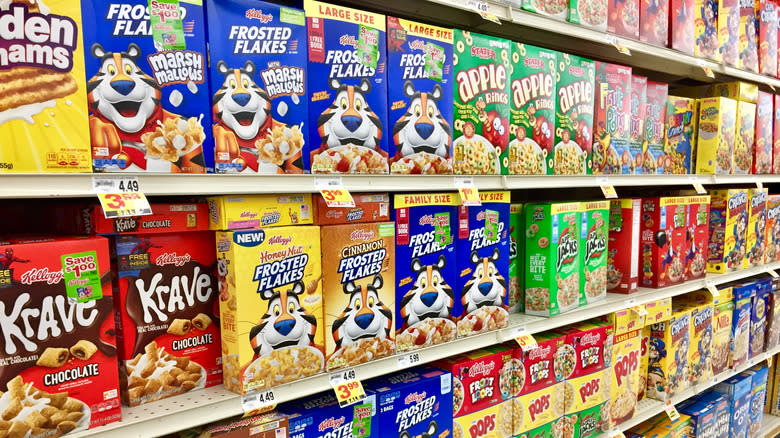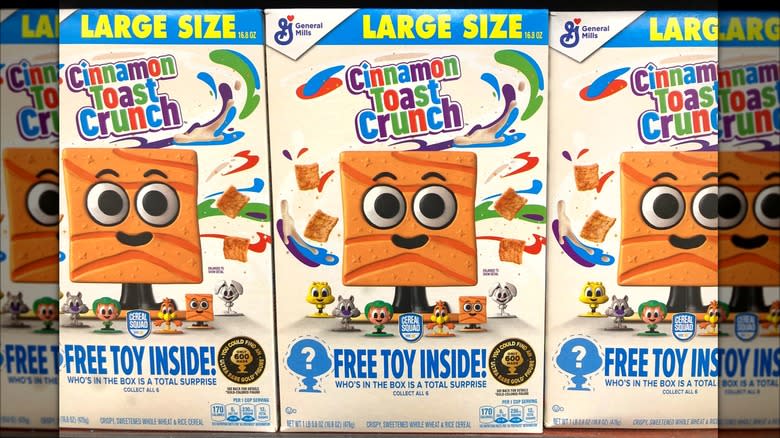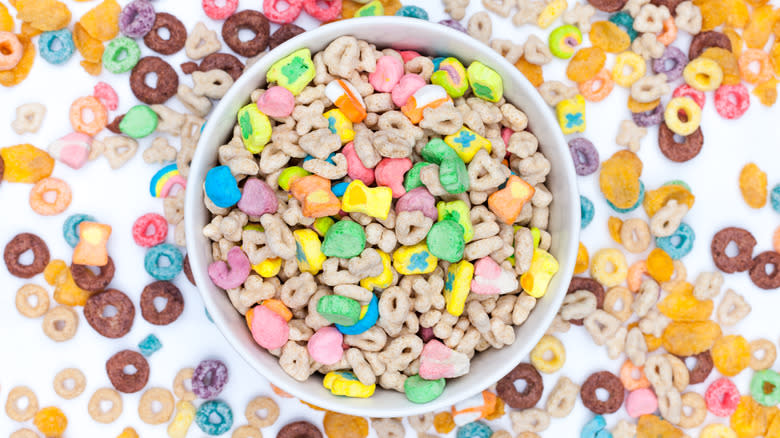How Kellogg's Paved The Way For Cereal Box Prizes

Breakfast cereals are known for being bright and colorful, which makes sense; during the mid-20th century, cereal started to be marketed more for kids than any other demographic, with colorful packaging and memorable mascots making their first appearances. But perhaps no phenomenon exemplified this approach more than the rise of toys and prizes nestled amid the cereal itself. For decades after, cereal box prizes -- toys like figurines, video games, and eating utensils -- were de rigeur; an integral part of the American breakfast experience. This led to plenty of arguments about which were the best cereal box prizes of all time.
But where did the idea come from to begin with? It turns out that it dates back way, way farther than you might expect: The very first prize to be offered with cereal was in the early 1900s. Unsurprisingly, the company responsible was also the one that effectively invented breakfast cereal: Kellogg's, whose bizarre accidental experiments were the origin of Corn Flakes. But it wasn't a toy as we recognize them today; those had to wait for decades to arrive.
Read more: 14 Of The Oldest Cereals Still On Shelves
Kellogg's Started The Trend, But General Mills Ran With It

To be fair, the first cereal box "prize" wasn't just not a toy, but it wasn't even an in-box prize. In the 1900s, the nascent Kellogg's offered a book called "The Funny Jungleland Moving Pictures Book" to children who mailed in proof of purchase for a box of Corn Flakes. But this was something of a limited run, as Corn Flakes weren't generally targeted to kids.
The company that really grabbed the reigns of cereal prize development was actually one of Kellogg's chief rivals: General Mills. In 1931, the company started putting 12 different "Skippy Cards" in boxes of Wheaties in an effort to get kids to try to collect them. General Mills actually beat Kellogg's to the punch with food-related prizes broadly, too: in the 1880s, they offered a coupon with Gold Medal flower that could net you a free teaspoon. But it was the 1931 promotion that really jumpstarted the trend of toys in cereal boxes, which only accelerated during the post-WWII baby boom era when marketing to kids spread far and wide.
Kellogg's Was Also Responsible For The Fall Of Cereal Toys

During the 2000s, cereal box toys began to disappear for a variety of reasons: Safety concerns over whether they constituted a choking hazard (the same reason why Kinder Surprise Eggs are illegal in America), health-related marketing restrictions placed on products targeting children, and environmental concerns about cheap, mass-produced plastic toys. Funny enough, though, the downward slide of cereal box prizes came much earlier, and it was due to the same company that started the trend in the first place: Kellogg's.
In 1988, the company had to issue a recall of 30 million toy binoculars and flutes after they were deemed a choking hazard. It didn't end cereal box toys, but it did result in manufacturers placing them between the bag and the box (rather than in the bag itself). This can only be regarded as the beginning of the end. The late 1990s and early 2000s saw a whole raft of lawsuits aimed at the idea these prizes were still a choking hazard, and by the 2010s, they were nonexistent. So Kellogg's may have started the trend, but they helped end it, too.
Read the original article on Daily Meal

